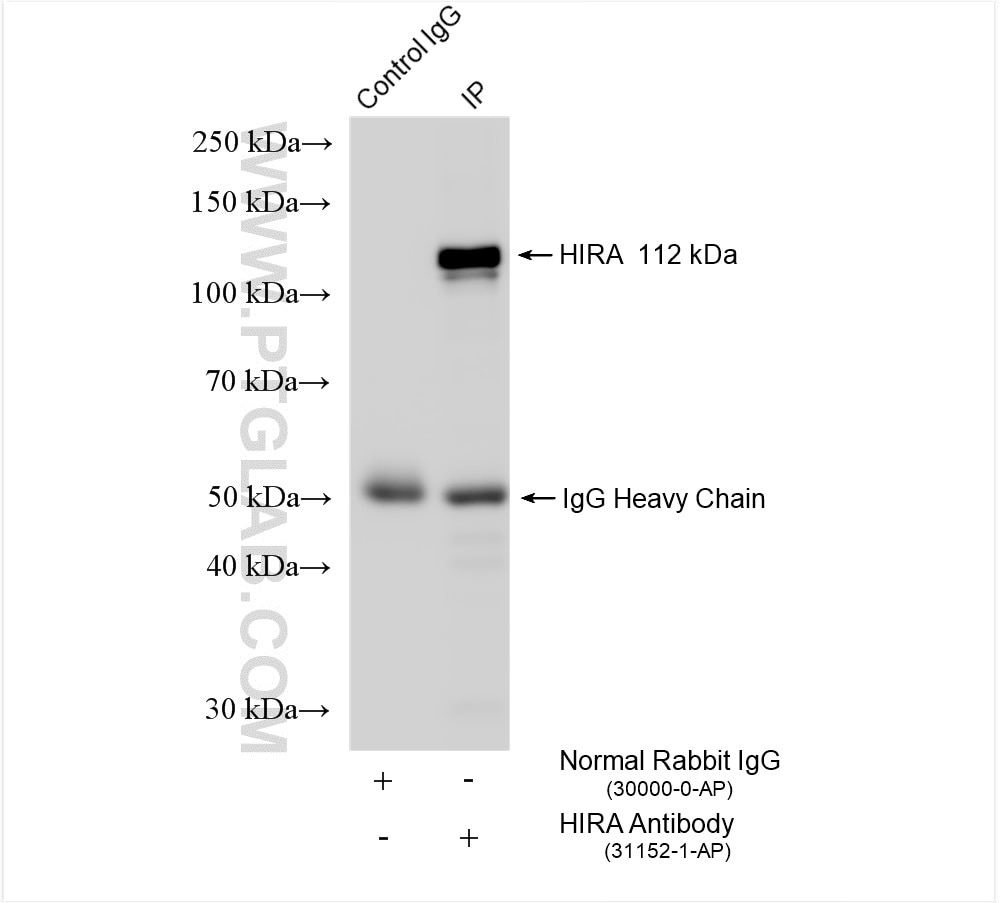Validation Data Gallery
Tested Applications
| Positive IP detected in | HepG2 cells, K-562 cells |
Recommended dilution
| Application | Dilution |
|---|---|
| Immunoprecipitation (IP) | IP : 0.5-4.0 ug for 1.0-3.0 mg of total protein lysate |
| It is recommended that this reagent should be titrated in each testing system to obtain optimal results. | |
| Sample-dependent, Check data in validation data gallery. | |
Product Information
31152-1-AP targets HIRA in IP, ELISA applications and shows reactivity with human samples.
| Tested Reactivity | human |
| Host / Isotype | Rabbit / IgG |
| Class | Polyclonal |
| Type | Antibody |
| Immunogen | HIRA fusion protein Ag34439 相同性解析による交差性が予測される生物種 |
| Full Name | HIR histone cell cycle regulation defective homolog A (S. cerevisiae) |
| Calculated molecular weight | 112 kDa |
| Observed molecular weight | 112 kDa |
| GenBank accession number | NM_003325 |
| Gene Symbol | HIRA |
| Gene ID (NCBI) | 7290 |
| RRID | AB_3669873 |
| Conjugate | Unconjugated |
| Form | Liquid |
| Purification Method | Antigen affinity Purification |
| UNIPROT ID | P54198 |
| Storage Buffer | PBS with 0.02% sodium azide and 50% glycerol , pH 7.3 |
| Storage Conditions | Store at -20°C. Stable for one year after shipment. Aliquoting is unnecessary for -20oC storage. |
Background Information
HIRA protein is encoded by a gene within a region of human chromosome 22q11.2 deleted in most patients with the DiGeorge syndrome, a developmental disorder, and was named for its amino acid sequence homology to two S. cerevisiae proteins, Hir1p and Hir2p. HIRA is critical in a specific chromatin assembly pathway that takes place independently of DNA synthesis (PMID: 12049744). HIRA complex associates with various proteins, such as transcription factors, RNA pol II, Prohibitin (PHB), and replication protein A (RPA) suggests that the targeting of the complex at specific locations may exploit additional structural properties and mechanisms (PMID: 30082790).
Protocols
| Product Specific Protocols | |
|---|---|
| IP protocol for HIRA antibody 31152-1-AP | Download protocol |
| Standard Protocols | |
|---|---|
| Click here to view our Standard Protocols |

